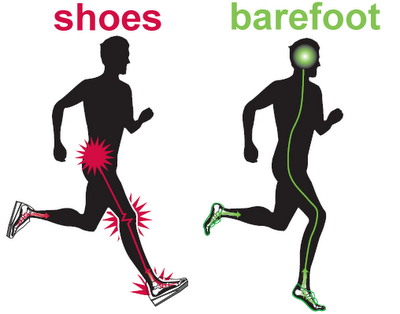Barefoot Running

Q: What are the benefits of running barefoot as opposed to running in shoes?
A: Barefoot running has been gaining popularity since Christopher McDougall’s book, “Born to Run,” was published in 2009. The book, as well as subsequent studies, suggests that modern athletic shoes don’t do much to prevent injuries or to increase a runner’s performance. Much of the research rests on the premise behind “heel striking” and how a runner’s form changes from one shoe to another. In barefoot running, whether due to necessity or comfort, athletes run on the balls of their feet, rather than the heels. This technique is said to lead to stronger feet and to use less energy than running in shoes.
Q: Is there anything I need to know before giving barefoot running a try?
A: Running — whether with or without shoes — isn’t for everyone. For many people, the best type of exercise is a lower-impact activity such as swimming, biking, walking or using an elliptical machine. To determine whether or not you should try barefoot running, consider these questions:
- Are you already a runner? Foot and ankle injuries related to barefoot running often occur in non-runners who try this technique first, before getting into strong running shape in general.
- Do you have a low body mass index? The top barefoot runners have one thing in common: lean muscle mass. If you carry around an extra 10 or 20 pounds, or if you’re just beginning to get in shape, I recommend starting with a supportive shoe for accurate weight distribution.
- Have you consulted a physician? It’s important to talk to a doctor — and ideally, a podiatrist — before dramatically changing your running form. Barefoot running uses an entirely different part of your foot. Getting advice from a foot specialist now may help you prevent injuries — and more doctor’s visits — later.
How can I switch safely from running in shoes to running barefoot?
A: Experiment with switching from traditional heel-strike running to striking with the balls of your feet — but do this while wearing your normal running shoes. Try it for small distances and evaluate how you feel on different surfaces and at different speeds.
Other measures include strengthening your legs and feet with toe raises, theraband exercises and calf stretches (a foot specialist can show you how).
If you start feeling pain or discomfort, whether on a run or while doing your exercises, don’t “push through it.” Pain in the arches or balls of the feet, or muscle soreness in the foot, could be a sign of an over-use injury. Stop the action that is causing the pain and follow up with your doctor.

